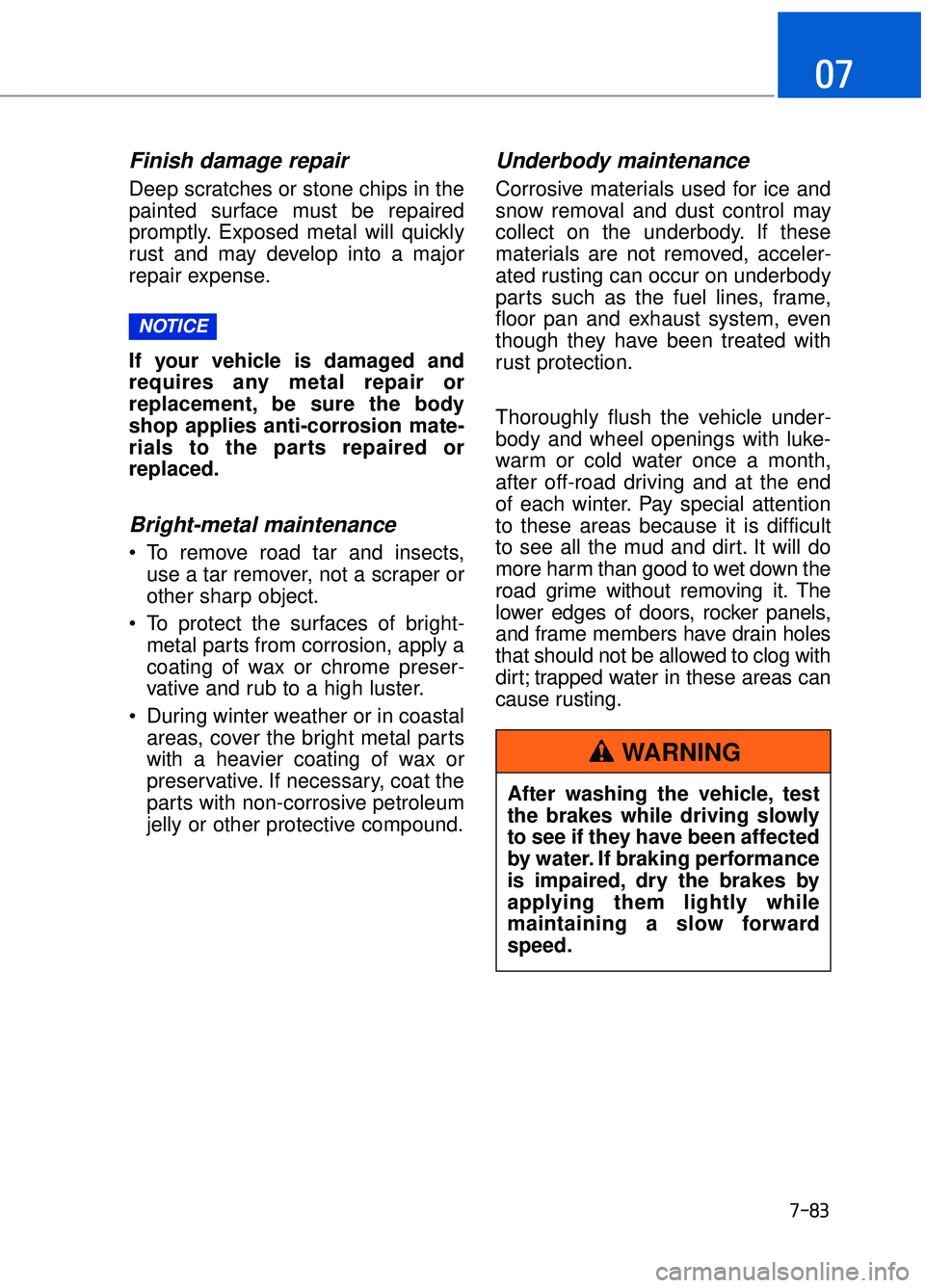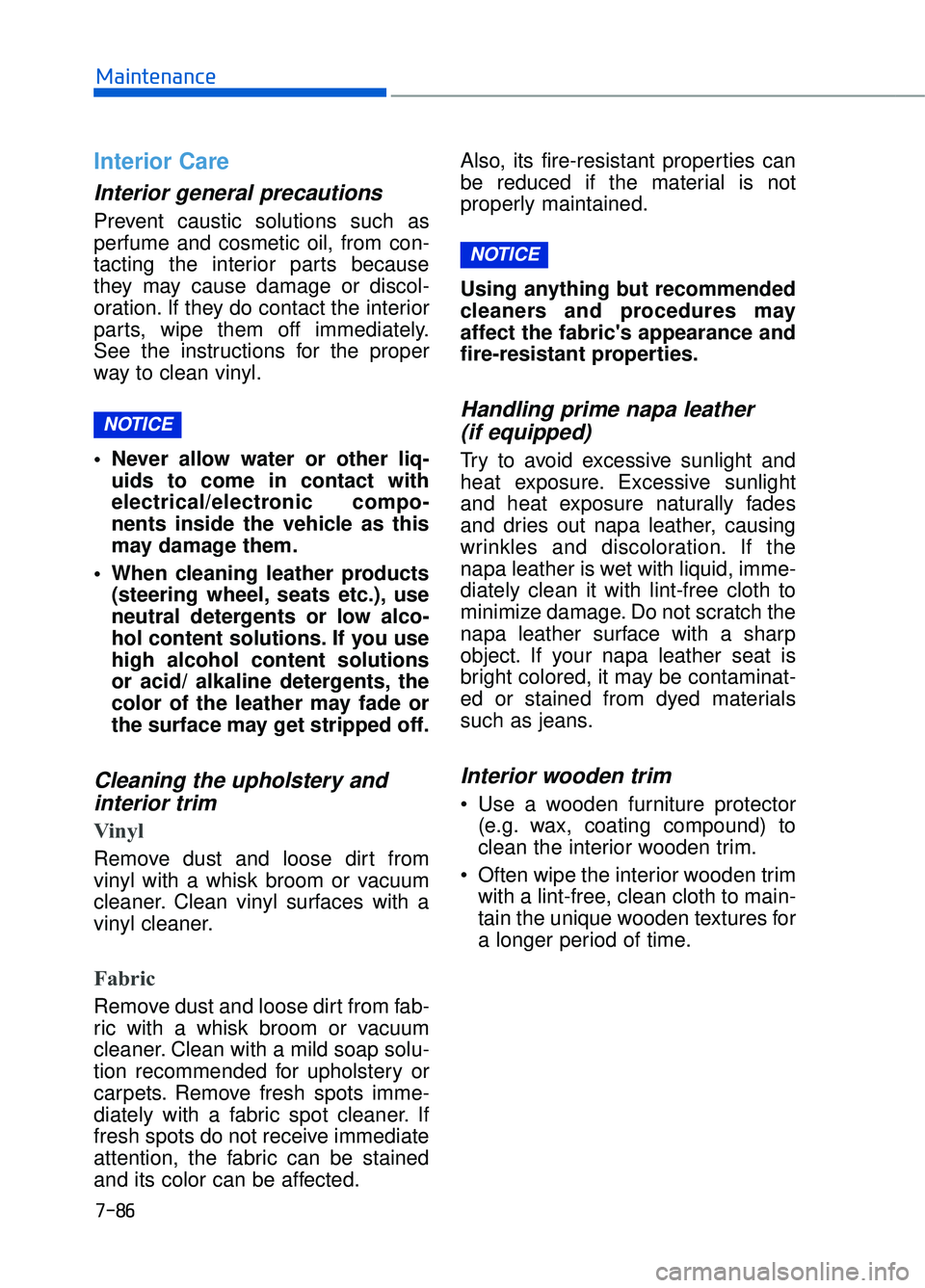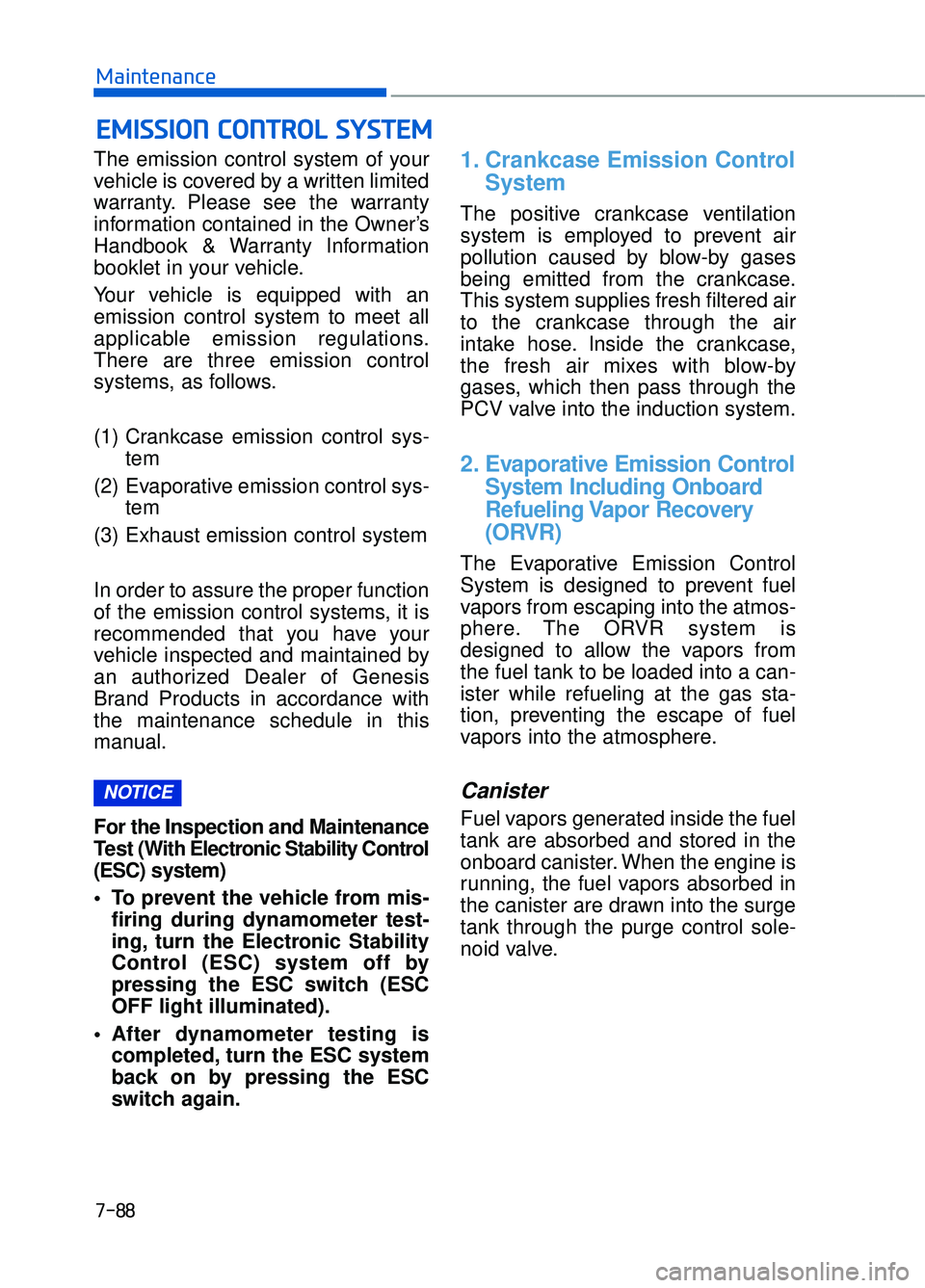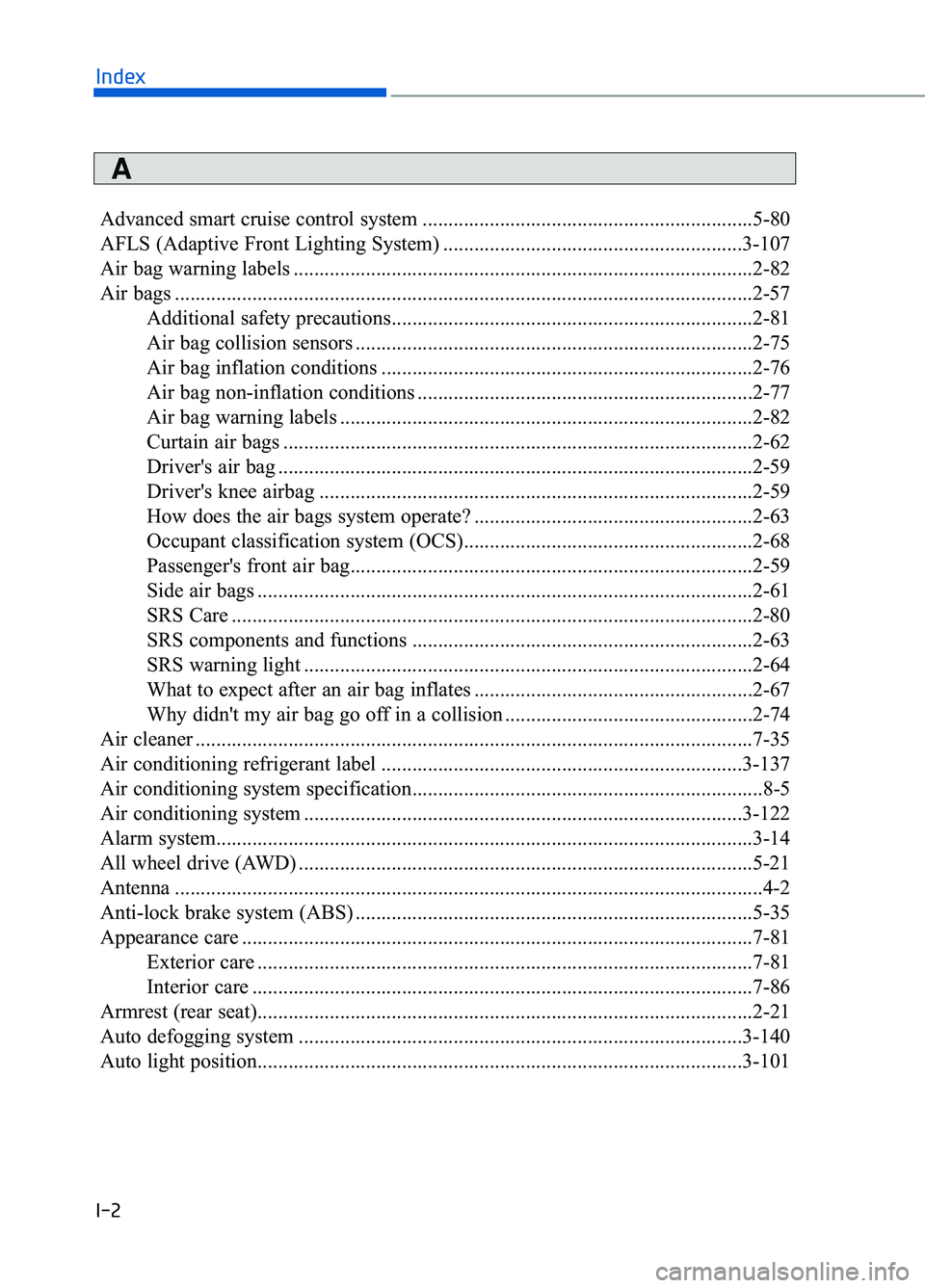light GENESIS G90 2017 Owner's Manual
[x] Cancel search | Manufacturer: GENESIS, Model Year: 2017, Model line: G90, Model: GENESIS G90 2017Pages: 524, PDF Size: 19.3 MB
Page 480 of 524

7-78
Maintenance
Information
If your vehicle is equipped with High
Intensity Discharge (HID) headlamps,
these headlamps contain mercury. So
if you need to have your vehicle dis-
posed, you should remove the HID
headlamps before disposal. The
removed HID headlamps should be
recycled, re-used or disposed as haz-
ardous waste.
Information
HID lamps have superior perform-
ance vs. halogen bulbs.
HID lamps are estimated by the man-
ufacturer to last twice as long or
longer than halogen bulbs depending
on their frequency of use. They will
probably require replacement at some
point in the life of the vehicle. Cycling
the headlamps on and off more than
typical use will shorten HID lamps
life. HID lamps do not fail in the same
manner as halogen incandescent
lamps. If a headlamp goes out after a
period of operation but will immedi-
ately relight when the headlamp
switch is cycled it is likely the HID
lamp needs to be replaced. HID light-
ing components are more complex
than conventional halogen bulbs thus
have higher replacement cost.
Parking lamp/Daytime running
light/Side marker
Your vehicle is equipped with LED
lamps. LED lamps do not have
replaceable bulbs. If the LED lamp
does not operate, have the vehicle
checked by an authorized Dealer of
Genesis Brand Products.
Type B – LED headlamp
(1) Headlamp (Low)
(2) Headlamp (High)
(3) Parking lamp
(4) Turn signal/Daytime running light
(5) Side marker
Your vehicle is equipped with LED
lamps. LED lamps do not have
replaceable bulbs. If the LED lamp
does not operate, have the vehicle
checked by an authorized Dealer of
Genesis Brand Products.
i
i
OHI076039N
Page 481 of 524

7-79
07
Side Repeater Lamp
Replacement
If the light bulb does not operate,
have the vehicle checked by an
authorized Dealer of Genesis Brand
Products.
Rear Combination Light Bulb
Replacement
(1) Stop/Tail lamp
(2) Turn signal/Backup lamp
(3) Side marker
Your vehicle is equipped with LED
lamps. LED lamps do not have
replaceable bulbs. If the LED lamp
does not operate, have the vehicle
checked by an authorized Dealer of
Genesis Brand Products.
High Mounted Stop Light
Replacement
Your vehicle is equipped with LED
lamps. LED lamps do not have
replaceable bulbs. If the LED lamp
does not operate, have the vehicle
checked by an authorized Dealer of
Genesis Brand Products.
License Plate Light
Replacement replacement
If the light bulb does not operate,
have the vehicle checked by an
authorized Dealer of Genesis Brand
Products.
OHI076041
OHI076043
OHI076044
OHI076040
Page 482 of 524

7-80
Maintenance
Your vehicle is equipped with LED
lamps. LED lamps do not have
replaceable bulbs. If the LED lamp
does not operate, have the vehicle
checked by an authorized Dealer of
Genesis Brand Products.
■Front lamps■Trunk room lamp
■ Rear lamps■Vanity mirror lamp
OHI076066L/OHI076068L/OHI076069L/OHI076046/OHI076045/OHI076071L/OHI07607\
0L
■
Glove box lamp
Interior Light Bulb Replacement
Page 483 of 524

7-81
07
Exterior Care
Exterior general caution
It is very important to follow the label
directions when using any chemical
cleaner or polish. Read all warning
and caution statements that appear
on the label.
High-pressure washing
When using high-pressure wash-ers, make sure to maintain suffi-
cient distance from the vehicle.
Insufficient clearance or excessive
pressure can lead to component
damage or water penetration.
Do not spray the camera, sensors or its surrounding area directly with
a high pressure washer. Shock
applied from high pressure water
may cause the device to not oper-
ate normally.
Do not bring the nozzle tip close to boots (rubber or plastic covers)or
connectors as they may be dam-
aged if they come into contact with
high pressure water.
Do not use any high-pressure noz- zles, which induce either one-direct
water stream or water swirling.
Finish maintenance
Washing
To help protect your vehicle’s finish
from rust and deterioration, wash it
thoroughly and frequently at least
once a month with lukewarm or cold
water.
If you use your vehicle for off-road
driving, you should wash it after each
off-road trip. Pay special attention to
the removal of any accumulation of
salt, dirt, mud, and other foreign
materials. Make sure the drain holes
in the lower edges of the doors and
rocker panels are kept clear and
clean.
Insects, tar, tree sap, bird droppings,
industrial pollution and similar
deposits can damage your vehicle’s
finish if not removed immediately.
Even prompt washing with plain
water may not completely remove all
these deposits. A mild soap, safe for
use on painted surfaces, should be
used.
After washing, rinse the vehicle thor-
oughly with lukewarm or cold water.
Do not allow soap to dry on the finish.
A AP
PP
PE
EA
A R
RA
A N
N C
CE
E
C
C A
A R
RE
E
After washing the vehicle, test
the brakes while driving slowly
to see if they have been affected
by water before getting on the
road. If braking performance is
impaired, dry the brakes by
applying them lightly while
maintaining a slow forward
speed.
WARNING
Page 484 of 524

7-82
Maintenance
Do not use strong soap, chemi- cal detergents or hot water, and
do not wash the vehicle in direct
sunlight or when the body of the
vehicle is warm.
Be careful when washing the side windows of your vehicle.
Especially, with high-pressure
water, water may leak through
the windows and wet the interior.
To prevent damage to the plastic parts, do not clean with chemi-
cal solvents or strong deter-
gents.
Water washing in the engine compartment including high
pressure water washing may
cause the failure of electrical cir-
cuits located in the engine com-
partment.
Never allow water or other liq- uids to come in contact with
electrical/electronic compo-
nents inside the vehicle as this
may damage them.
Waxing
A good coat of wax provides a barri-
er between your paint and environ-
mental contamination.
Keeping a good coat of wax on your
vehicle will help protect it.
Wax the vehicle when water will no
longer bead on the paint.
Always wash and dry the vehicle
before waxing. Use a good quality
liquid or paste wax, and follow the
manufacturer’s instructions. Wax all
metal trim to protect it and to main-
tain its luster.
Removing oil, tar, and similar materi-
als with a spot remover will usually
strip the wax from the finish. Be sure
to re-wax these areas even if the rest
of the vehicle does not yet need wax-
ing.
Wiping dust or dirt off the bodywith a dry cloth will scratch the
finish.
Do not use steel wool, abrasive cleaners, or strong detergents
containing highly alkaline or
caustic agents on chrome-plat-
ed or anodized aluminum parts.
This may result in damage to the
protective coating and cause
discoloration or paint deteriora-
tion.
NOTICE
NOTICE
NOTICE
OHI076049N
Page 485 of 524

7-83
07
Finish damage repair
Deep scratches or stone chips in the
painted surface must be repaired
promptly. Exposed metal will quickly
rust and may develop into a major
repair expense.
If your vehicle is damaged and
requires any metal repair or
replacement, be sure the body
shop applies anti-corrosion mate-
rials to the parts repaired or
replaced.
Bright-metal maintenance
To remove road tar and insects,use a tar remover, not a scraper or
other sharp object.
To protect the surfaces of bright- metal parts from corrosion, apply a
coating of wax or chrome preser-
vative and rub to a high luster.
During winter weather or in coastal areas, cover the bright metal parts
with a heavier coating of wax or
preservative. If necessary, coat the
parts with non-corrosive petroleum
jelly or other protective compound.
Underbody maintenance
Corrosive materials used for ice and
snow removal and dust control may
collect on the underbody. If these
materials are not removed, acceler-
ated rusting can occur on underbody
parts such as the fuel lines, frame,
floor pan and exhaust system, even
though they have been treated with
rust protection.
Thoroughly flush the vehicle under-
body and wheel openings with luke-
warm or cold water once a month,
after off-road driving and at the end
of each winter. Pay special attention
to these areas because it is difficult
to see all the mud and dirt. It will do
more harm than good to wet down the
road grime without removing it. The
lower edges of doors, rocker panels,
and frame members have drain holes
that should not be allowed to clog with
dirt; trapped water in these areas can
cause rusting.
NOTICE
After washing the vehicle, test
the brakes while driving slowly
to see if they have been affected
by water. If braking performance
is impaired, dry the brakes by
applying them lightly while
maintaining a slow forward
speed.
WARNING
Page 488 of 524

7-86
Maintenance
Interior Care
Interior general precautions
Prevent caustic solutions such as
perfume and cosmetic oil, from con-
tacting the interior parts because
they may cause damage or discol-
oration. If they do contact the interior
parts, wipe them off immediately.
See the instructions for the proper
way to clean vinyl.
Never allow water or other liq-uids to come in contact with
electrical/electronic compo-
nents inside the vehicle as this
may damage them.
When cleaning leather products (steering wheel, seats etc.), use
neutral detergents or low alco-
hol content solutions. If you use
high alcohol content solutions
or acid/ alkaline detergents, the
color of the leather may fade or
the surface may get stripped off.
Cleaning the upholstery andinterior trim
Vinyl
Remove dust and loose dirt from
vinyl with a whisk broom or vacuum
cleaner. Clean vinyl surfaces with a
vinyl cleaner.
Fabric
Remove dust and loose dirt from fab-
ric with a whisk broom or vacuum
cleaner. Clean with a mild soap solu-
tion recommended for upholstery or
carpets. Remove fresh spots imme-
diately with a fabric spot cleaner. If
fresh spots do not receive immediate
attention, the fabric can be stained
and its color can be affected. Also, its fire-resistant properties can
be reduced if the material is not
properly maintained.
Using anything but recommended
cleaners and procedures may
affect the fabric's appearance and
fire-resistant properties.
Handling prime napa leather
(if equipped)
Try to avoid excessive sunlight and
heat exposure. Excessive sunlight
and heat exposure naturally fades
and dries out napa leather, causing
wrinkles and discoloration. If the
napa leather is wet with liquid, imme-
diately clean it with lint-free cloth to
minimize damage. Do not scratch the
napa leather surface with a sharp
object. If your napa leather seat is
bright colored, it may be contaminat-
ed or stained from dyed materials
such as jeans.
Interior wooden trim
(e.g. wax, coating compound) to
clean the interior wooden trim.
Often wipe the interior wooden trim with a lint-free, clean cloth to main-
tain the unique wooden textures for
a longer period of time.
NOTICE
NOTICE
Page 490 of 524

7-88
Maintenance
The emission control system of your
vehicle is covered by a written limited
warranty. Please see the warranty
information contained in the Owner’s
Handbook & Warranty Information
booklet in your vehicle.
Your vehicle is equipped with an
emission control system to meet all
applicable emission regulations.
There are three emission control
systems, as follows.
(1) Crankcase emission control sys- tem
(2) Evaporative emission control sys- tem
(3) Exhaust emission control system
In order to assure the proper function
of the emission control systems, it is
recommended that you have your
vehicle inspected and maintained by
an authorized Dealer of Genesis
Brand Products in accordance with
the maintenance schedule in this
manual.
For the Inspection and Maintenance
Test (
With Electronic Stability Control
(ESC)
system)
To prevent the vehicle from mis- firing during dynamometer test-
ing, turn the Electronic Stability
Control (ESC) system off by
pressing the ESC switch (ESC
OFF light illuminated).
After dynamometer testing is completed, turn the ESC system
back on by pressing the ESC
switch again.
1. Crankcase Emission Control System
The positive crankcase ventilation
system is employed to prevent air
pollution caused by blow-by gases
being emitted from the crankcase.
This system supplies fresh filtered air
to the crankcase through the air
intake hose. Inside the crankcase,
the fresh air mixes with blow-by
gases, which then pass through the
PCV valve into the induction system.
2. Evaporative Emission ControlSystem Including Onboard
Refueling Vapor Recovery
(ORVR)
The Evaporative Emission Control
System is designed to prevent fuel
vapors from escaping into the atmos-
phere. The ORVR system is
designed to allow the vapors from
the fuel tank to be loaded into a can-
ister while refueling at the gas sta-
tion, preventing the escape of fuel
vapors into the atmosphere.
Canister
Fuel vapors generated inside the fuel
tank are absorbed and stored in the
onboard canister. When the engine is
running, the fuel vapors absorbed in
the canister are drawn into the surge
tank through the purge control sole-
noid valve.
NOTICE
E EM
M I
IS
S S
SI
IO
O N
N
C
C O
O N
NT
TR
R O
O L
L
S
S Y
Y S
ST
T E
EM
M
Page 496 of 524

B
BU
U L
LB
B
W
W A
AT
TT
TA
A G
G E
E
8-3
08
Light bulb Wattage Bulb type
Front Headlamp
Low
Type A 35 D1S
Type B LED LED
High Type A 35 D1S
Type B LED LED
Turn signal lamp
LED LED
Parking lamp
Side maker
Daytime running light (DRL)
Side repeater lamp (Outside mirror)
Rear Rear combination lamp Stop/Tail
LED LED
Turn signal
Backup
Side marker
High mounted stop lamp
License plate lamp
Interior Map lamp
LED LED
Room lamp
Front/Rear vanity mirror lamp
Globe box lamp
Trunk room lamp
Personal lamp
Page 506 of 524

Advanced smart cruise control system ................................................................5-80
AFLS (Adaptive Front Lighting System) ..........................................................3-107
Air bag warning labels ........................................................................\
.................2-82
Air bags ........................................................................\
........................................2-57Additional safety precautions......................................................................2-\
81
Air bag collision sensors ........................................................................\
.....2-75
Air bag inflation conditions ........................................................................\
2-76
Air bag non-inflation conditions .................................................................2-77
Air bag warning labels ........................................................................\
........2-82
Curtain air bags ........................................................................\
...................2-62
Driver's air bag ........................................................................\
....................2-59
Driver's knee airbag ........................................................................\
............2-59
How does the air bags system operate? ......................................................2-63
Occupant classification system (OCS)........................................................2-68
Passenger's front air bag........................................................................\
......2-59
Side air bags ........................................................................\
........................2-61
SRS Care ........................................................................\
.............................2-80
SRS components and functions ..................................................................2-63
SRS warning light ........................................................................\
...............2-64
What to expect after an air bag inflates ......................................................2-67
Why didn't my air bag go off in a collision ................................................2-74
Air cleaner ........................................................................\
....................................7-35
Air conditioning refrigerant label ......................................................................3-\
137
Air conditioning system specification....................................................................8-5
Air conditioning system ........................................................................\
.............3-122
Alarm system........................................................................\
................................3-14
All wheel drive (AWD) ........................................................................\
................5-21
Antenna ........................................................................\
..........................................4-2
Anti-lock brake system (ABS) ........................................................................\
.....5-35
Appearance care ........................................................................\
...........................7-81 Exterior care ........................................................................\
........................7-81
Interior care ........................................................................\
.........................7-86
Armrest (rear seat)........................................................................\
........................2-21
Auto defogging system ........................................................................\
..............3-140
Auto light position........................................................................\
......................3-101
I-2
Index
A